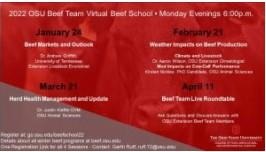By Garth Ruff
On January 24, the OSU Beef Team was pleased to host a 2022 Beef Market Outlook meeting featuring Dr. Andrew Griffith, Associate Professor of Agriculture and Resource Economics at the University of Tennessee. Dr. Griffith covered the usual supply, demand, and market projections as well as some insight to supply chain disruptions, input costs, and beef industry trends.

Are you signed up for all sessions?
This article will highlight some of the main points of Dr. Griffith’s talk which can be viewed in its entirety on the Beef Team YouTube channel at https://youtu.be/crVWE51aLrc or found embedded below.
Supply – Cow numbers are down, in large part due to long lasting drought that has gripped most of the country west of the Mississippi River. Heifer slaughter was up over 4% compared to 2020 and cull cow slaughter was up nearly 10% compared to the prior year. This reduction of the cow herd Dr. Griffith said will allow for strong fed cattle and feeder prices, “in 2022, 2023, and potentially in 2024 depending on heifer replacement rates.”
Demand – Partially fueled by the COVID pandemic, demand for beef continues to be strong for both export and domestic markets. Dr. Griffith highlighted that in 2021 China became the third largest importer of US beef, behind Japan and South Korea. The surge of US beef into China can be attributed to the Trump administration’s US-China trade agreement for agricultural products. Domestic demand continues to be string as well, with the demand for locally produced beef as strong as ever.
Prices – All told the price forecast looks very favorable for the remainder of the year even with increases in production costs. Fed live cattle prices were very strong in the back half of 2021 and look to trade in the $140’s cwt for a large portion of 2022. Dr. Griffith’s sentiment was that “cow-calf producers who cannot make a profit with $1,000/head for weaned calves, even with increased production costs, may want to pick up croquet or consider another profession.” There also appears to be opportunities to market heavier 700-800 lb. calves at premium prices from April to August based current futures prices. Producers should look at their herd and consider culling those poorer preforming and open cows, as the slaughter cow market remains strong.
Supply Chain – Dr. Griffith touched on some of the various legislation and regulation being proposed regarding the beef industry. While not opposed to increased negotiated trade and price discovery, he acknowledged that it does come at a cost. Dr. Griffith also commented on the point that more packers doesn’t necessarily translate to higher cattle prices.
Input Costs – Feed, fertilizer, chemicals are all going to be higher this year. Weather will be different this year. “If you’re trying to farm exactly like you did it last year, you’re probably doing it wrong. Unless you did it wrong last year, and that might be the case, and maybe you got it right, this year, because every year is different,” Dr. Griffith.
Source : osu.edu